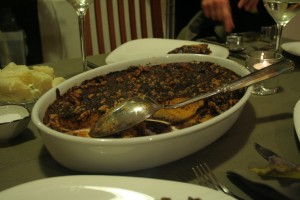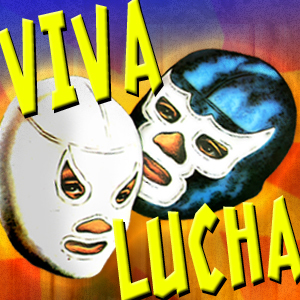Posts Tagged ‘latin american food’
It’s Ceviche Time!11.22.10
It was time for Sunday supper in NYC.
The seafood had been chilling in the fridge, soaking up the flavors of a clear, citrus broth. This was my first attempt at preparing ceviche, the classic dish of cured seafood from the kitchens of Peru and Ecuador, and judging from the delicate flavors and textures it yielded, it would definitely not be my last. I caught the last wave of local tomatoes, dicing their bright red flesh and piling them over the succulent seafood that had been marinating for a couple of hours. On top of those juicy cubes, I added crunchy bits of green pepper, finely chopped slivers of white onion, and fragrant cilantro and parsley that turned out to look a lot like kitchen confetti.
We laid out small bowls throughout the dining table, each one filled with thinly sliced plantains, airy popcorn and chunks of crusty French bread. All these garnishes would create a symphony of textures to accompany the cool, clean dish. We bit into the plump pink shrimp, nibbled delicately on the silky mussels and popped the morsels of scallops and miniature clams into our mouths. We sipped on cold white wine, while talking and laughing.
That afternoon I had visited the food markets of the Upper West Side, and after getting home, I turned to The South American Table cookbook for guidance. The result was a light and flavorful meal: the orange and mustard in the marinade gave the seafood a sweet and tangy note, the toppings gave it crunch and a lemony freshness. The different garnishes added an interactive component that was a hit.
This weekend, a hint of Spring was in the air. It was time to venture into something new.
Shellfish Ceviche Serves 6 (I served it as a meal, but you can also make it as an appetizer at your next dinner party)
4 cups water
1 scallion, sliced
1 lb. medium shrimp, peeled and deveined
½ lb. bay scallops
¼ cup dry white wine
1 lb. mussels, scrubbed and deveined
16 baby clams
MARINADE
1/3 cup lemon juice
1/3 cup lime juice
2/3 cup orange juice
½ cup chicken broth
1 tablespoon extra virgin olive oil
1 teaspoon Dijon mustard
1 teaspoon Worcestershire sauce
½ teaspoon sugar
½ teaspoon salt
¼ teaspoon black pepper
Hot sauce
GARNISHES
1 medium tomato, peeled, seeded and finely chopped
1 small green bell pepper, seeded and finely chopped
1 small onion, finely chopped, rinsed with hot water and drained
2 tablespoons fresh cilantro
2 tablespoons fresh parsley
SIDE DISHES
Popcorn, plantain chips (chifles), French bread, ripe avocado
INSTRUCTIONS
In a large saucepan, bring water and scallions to a boil, reduce heat and simmer for 5 minutes. Add shrimp, remove from heat and let stand for a few seconds until the shrimp turn pink. Remove shrimp and rinse under cold water.
Add scallops to the cooking liquid and bring back to boil. Remove from heat, cover and let stand for 3 minutes. Once scallops are cooked through (their center should be white), drain and rinse under cold water.
Place wine, mussels and clams in large skillet and bring to boil. Cover and continue to boil until shells are open, 3 to 5 minutes. Remove clams ad mussels from their shells.
Make marinade by combining all the ingredients in a large glass or ceramic bowl. Stir in shrimp, scallops, mussels and clams. Mix well, cover with plastic wrap and refrigerate for at least 2 hours.
Before serving, taste for salt, sugar and spice. Serve with garnishes and side dishes.
Latin flavors dominate the scene10.22.10
The Culinary Institute of America held a seminar about Latin American food called “Latin Flavors, American Kitchens” in its San Antonio campus, with guest chefs including Rick Bayless and Maricel Presilla, two established chefs and ambassadors to Latin American cuisine in the U.S. More and more, Latin American food appears to be influencing restaurant menus throughout the country. Check out the latest newcomer to the Nuevo-Latino food scene in NYC, Nuela. Also, eaters are moving away from fine dining to more casual establishments, which has given opportunities for more Latin American restaurants to break through the market. That is some excellent news, can’t wait to see what the next knock out will be!
Read more about what happened at CIA here.
Alexia’s Pastelón11.29.09
 This is the moment you’ve been waiting for.
This is the moment you’ve been waiting for.
Throughout the past 5 days, I’ve gotten many requests for this recipe. Although we are now in the December holiday territory, I urge you to make this sweet potato casserole, or pastelón in Dominican. I got the recipe from my cousin Alexia whom I love with all my heart.(gracias alexia!) Now, it is in your hands my friends. All I can say is that once you make this, prepare to be loved, your holidays will never be quite the same again.
Alexia’s Thanksgiving Pastelón
3 cups mashed sweet potatoes
1 cup sugar
½ cup butter
2 eggs
1 teaspoon vanilla*
½ can of evaporated milk
Ground cinnamon*
Pancake syrup*
Peal the sweet potatoes, cut in quarters and boil in salted water for approx 30 minutes or until soft. Drain and mash slowly with a fork. Add the butter, sugar, evaporated milk, vanilla, cinnamon, maple syrup and the egg yolks.
Beat the egg whites and fold in the mixture. Place in baking dish.
Cover with the topping below.
Topping:
½ cup brown sugar
¼ cup all purpose flour
2 1/2 teaspoons butter (hard)
½ cup chopped walnuts
Ground cinnamon
Bake at 350F for approx. 30 minutes.
* Means: “al ojo” or approximate measurements
Marshmallow woman
When you think of Thanksgiving, what is the first thing that comes to mind? For me it’s a can of jellied cranberry, which I thought was the best cranberry sauce in the world. It is when I moved to the northeastern U.S. that I suddenly started thinking twice about it, and eventually got more snobby with my cranberry sauce, choosing more natural interpretations that could be traced back to the actual fruit. What I finally realized was that what I had been serving with turkey all those years, was a far cry from the deep burgundy sauce prepared in kitchens all over the country with sugar, water, spices and of course cranberries.
In the Dominican Republic, unless you’re somehow linked to the U.S.(have family here, have studied here, have an American spouse, etc), Thanksgiving is not a popular holiday. In my home though, the celebration was welcome every year. Mom instituted the tradition after celebrating it herself with her own family. Although the stories were always nebulous, I gathered that her father, my grandfather, had lived in Puerto Rico and had himself adopted the tradition.
Decades later, my kitchen in Santo Domingo buzzed whenever Turkey day would come along. My aunt Tiita took over one of the counters, mixing her secret “Russian” potato salad adding a little of this and a little of that until it was just perfect. Mom pulled out the glistening golden turkey for one last baste. Plantain pasteles filled with shredded chicken boiled in a huge pot. Piping hot rice with kidney beans (moro) was scooped into a huge bowl, sweet potato casserole with marshmallows toasted in the oven.
The table was set. The feast was underway. I had the task of slicing the cranberry “sauce”. I loved the feel of my knife going through the shiny jelly shaped like its can. I loved how each ring was equal to the next and I took pride in lining them up, each one resting on the next. Then families and friends who had gathered on the terrace enjoying the (hopefully) cooler breezes of November and laughing and drinking would gather round the table. My Mom would give thanks, her spirit as bright as her blond bob. We would dig into the spread of American and Dominican dishes, and forget that these moments existed only for that day.
In our minds, they would always come again, they would last forever.
Turtle Stew and Chicharrón08.06.09
At first glance, you may think this pairing comes straight out of Bizarre Foods. However, at Luz Restaurant in the Cayman Islands, these two dishes are bestsellers on the menu. Staples of the Caymanian and Honduran kitchens come together in this casual Georgetown eatery which serves traditional Caymanian fare like turtle stew and stewed conch and a list of Honduran delicacies like garnaches (corn tortillas topped with cheese, cabbage and beans), chicharrón con yuca(fried pork rinds with yucca), and carne asada (roast beef). On my last trip to this sunny sanctuary, I learned about the important Honduran presence in the Caymans and that people from the Bay Islands of Honduras have been crossing the Caribbean Sea and settling in the Cayman Islands for years.
It started in the 40’s and 50’s, when local Caymanians traveled to the English-speaking Bay Islands by catboats for food and resources limited by the arid local soil. Located about 145 nautical miles away, they were easily accessible. The Bay Islands’ history includes many disputes between Spain and England during colonial times, so much so that English is mostly spoken here despite the fact that Spanish is the official language of Honduras.
To Caymanians, Spanish is synonimous with people from Honduras. It’s incredible to think how Latin America is alive in the most unexpected of places.



Food For Thought